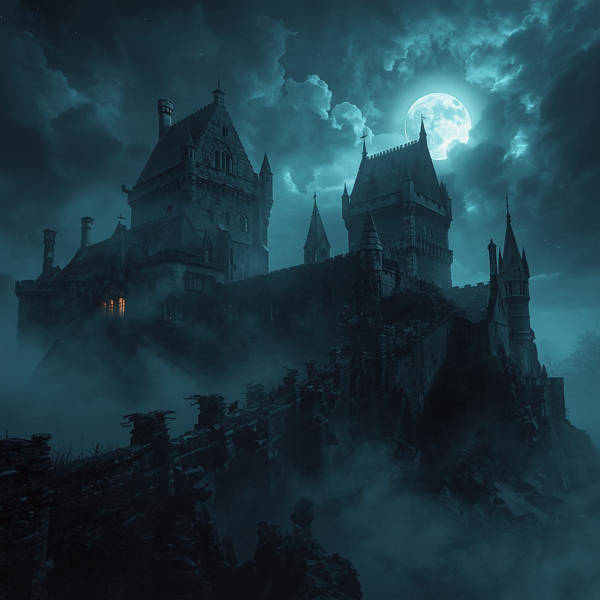
There is something uniquely captivating about the haunted castles of the United Kingdom. Their weathered stone walls, dark corridors, and ancient legends make them some of the most atmospheric places on Earth. But behind every chilling ghost story lies real history — stories of betrayal, tragedy, love, and revenge that shaped the myths we still tell today.
From the misty Scottish Highlands to the rugged coastlines of Wales, from England’s royal fortresses to Northern Ireland’s eerie ruins, the UK’s haunted castles offer a fascinating blend of fact and folklore. This article explores the true stories behind the most famous castle hauntings, revealing how history gave birth to legend — and why these spirits still seem to walk the halls.
👑 1. The Tower of London (England): The Queen’s Ghostly Prison
No list of haunted castles would be complete without the Tower of London, perhaps the most haunted building in Britain.
🕯️ The Historical Background
Built by William the Conqueror in the 1070s, the Tower served as both a royal palace and a state prison. Over nine centuries, it witnessed executions, betrayals, and political conspiracies, making it a perfect breeding ground for ghost stories.
👻 The Famous Hauntings
The most famous ghost is Anne Boleyn, the ill-fated second wife of King Henry VIII. Beheaded in 1536, Anne is said to wander the Tower’s chapel, sometimes carrying her own head. Guards have reported seeing her ghost in the Chapel Royal of St. Peter ad Vincula, where she was buried.
Other apparitions include:
- The Princes in the Tower – the young sons of Edward IV, allegedly murdered in 1483, whose ghostly figures have been seen playing in the fortress’s halls.
- Lady Jane Grey, the “Nine Days’ Queen,” executed in 1554, said to appear in sorrowful silence each anniversary of her death.
⚖️ The Truth Behind the Tales
The Tower’s haunted reputation reflects the brutality of Tudor politics. Many “ghosts” represent real victims of power struggles. The legends survive not only because of the eerie setting but because they symbolize the tragic human cost of ambition and betrayal.
🏰 2. Edinburgh Castle (Scotland): A Fortress of Spirits
Perched on a volcanic rock, Edinburgh Castle dominates Scotland’s capital — and its ghostly history is as impressive as its skyline.
⚔️ A Long and Violent Past
The site has been occupied since the Iron Age and has witnessed countless battles, from medieval sieges to Jacobite uprisings. It also served as a prison and military fortress, where many died in terrible conditions.
👻 The Ghostly Residents
Visitors and staff have reported footsteps, shadowy figures, and sudden temperature drops in the castle’s dungeons and underground vaults. Among its supposed spirits are:
- The Headless Drummer, whose sound is said to warn of danger to the castle.
- A Piper who disappeared centuries ago while exploring a secret tunnel. His music is still heard faintly below the castle.
- Prisoners of war from the American Revolution and Napoleonic Wars, who allegedly appear in rags and chains.
🧭 History Behind the Myths
Edinburgh Castle’s ghosts likely stem from centuries of war and imprisonment. Thousands of lives were lost or broken within its walls, and local oral tradition preserved their suffering through supernatural tales. The piper story, for example, may reflect real underground explorations during the 17th century — dramatized over time into a legend.
💔 3. Chillingham Castle (Northumberland, England): The “Most Haunted Castle”
Located near the Scottish border, Chillingham Castle has earned the nickname “Britain’s most haunted castle”. Its medieval origins and gruesome history of torture make it a favorite among ghost hunters.
⚔️ A Place of Conflict and Cruelty
Built in the 12th century, Chillingham was a fortress during the Anglo-Scottish wars. It later became infamous for its torture chamber, where prisoners were mutilated or killed — a dark legacy that fuels its haunted reputation.
👻 Ghosts of Chillingham
- The Blue Boy: Perhaps the castle’s most famous spirit. For centuries, guests reported seeing a blue light or a child’s crying echo near the Pink Room.
- In the 1920s, renovations uncovered the skeleton of a boy and fragments of blue clothing within the wall — confirming part of the legend.
- The Lady in White: Thought to be a noblewoman locked away and starved to death. Her scent of roses is said to appear before she manifests.
- The Torturer’s Ghost: Believed to be John Sage, a brutal executioner who was later killed by villagers.
🕯️ The Real Story
Chillingham’s haunted tales have roots in its real medieval violence. Its proximity to the border meant constant raids and executions. Modern discoveries — like the boy’s remains — show that some ghost stories began with genuine tragedy, later embellished through oral storytelling.
👸 4. Glamis Castle (Scotland): Secrets of Royal Shadows
Few places in the UK combine royal heritage and dark folklore quite like Glamis Castle.
👑 A Royal Home with a Dark Past
Located in Angus, Glamis has been the ancestral seat of the Bowes-Lyon family, relatives of Queen Elizabeth II. But behind its majestic appearance lies a series of terrifying legends that stretch back centuries.
👻 The Ghosts of Glamis
- The Monster of Glamis: Perhaps the castle’s most disturbing tale. According to legend, a deformed child was born into the family and hidden away in a secret chamber for life.
- Lady Janet Douglas: A real historical figure executed for witchcraft in 1537, though her “crime” was likely political. Her ghost is said to haunt the chapel, praying for peace.
- The Grey Lady: A sorrowful apparition believed to be the same Lady Douglas, seen gliding near the clock tower.
📜 Historical Truth and Legend
The monster story likely arose from the Victorian fascination with hidden deformities and family secrets, while Lady Douglas’s ghost has clear historical grounding. She was falsely accused by King James V, and her brutal execution left a lasting scar on Scottish memory. Glamis, therefore, embodies the intersection of royal history and myth, where injustice and imagination intertwine.
⚰️ 5. Berry Pomeroy Castle (Devon, England): The Lady Ghosts of the West
Hidden in a wooded valley, Berry Pomeroy Castle is one of England’s most romantic — and haunted — ruins.
🏰 The Pomeroy and Seymour Families
Built in the 15th century, the castle was once home to the powerful Pomeroy and later Seymour families. But it soon fell into decay, leaving behind a shell filled with mystery.
👻 The Two Ladies
Berry Pomeroy’s legends focus on two female spirits:
- The White Lady, believed to be Lady Margaret Pomeroy, who was imprisoned and starved to death by her jealous sister, Eleanor.
- The Blue Lady, a more sinister figure, said to lure men into the castle’s depths — possibly representing an ancestral spirit linked to a dark family tragedy.
🕰️ Reality Behind the Myths
While no records confirm Margaret’s murder, rivalry between the sisters was real. The haunting reflects historical patterns of female confinement and jealousy common in medieval noble families. The Blue Lady myth likely evolved as a cautionary tale, warning of temptation and moral corruption.
⚔️ 6. Cardiff Castle (Wales): Echoes of Roman and Victorian Spirits
At the heart of Wales’s capital stands Cardiff Castle, a site layered with 2,000 years of history — from Roman fort to Norman stronghold to Gothic mansion.
🕯️ Layers of the Past
Built over a Roman fort, Cardiff Castle later became a Norman fortress and then the Victorian fantasy residence of the Marquess of Bute. Such a long and varied history naturally bred ghostly legends.
👻 The Phantom Soldier
Many visitors claim to have seen a Roman centurion marching through the castle walls — a spirit believed to date back to the original garrison. Others report voices and footsteps echoing through the medieval keep.
📜 The Historical Connection
Roman soldiers were indeed stationed at the site as early as the 3rd century CE. The vision of a phantom centurion may represent a psychological echo of Cardiff’s Roman foundations, blending archaeology and imagination into one enduring myth.
🏴☠️ 7. Ballygally Castle (Northern Ireland): The Friendly Ghost
On the Antrim coast stands Ballygally Castle, built in 1625 and now a luxury hotel. Unlike other haunted castles, its resident spirit is not malicious, but tragically misunderstood.
💔 The Story of Lady Isobel Shaw
According to local tradition, Lady Isobel Shaw, wife of Lord James Shaw, was locked in a tower after giving birth to a daughter instead of a son. Trying to escape, she fell — or was pushed — from the window. Her ghost is said to knock on guests’ doors, still searching for her lost child.
🕯️ The Real History
Records confirm that the Shaw family owned the castle in the 17th century, and while Lady Isobel’s death remains uncertain, the legend reflects the harsh expectations placed on women in noble families. Ballygally’s haunting endures not because it terrifies, but because it moves — a story of love, loss, and maternal longing.
🧙♀️ 8. Why Haunted Castles Still Fascinate Us
The UK’s haunted castles attract millions of visitors each year — not only for their beauty, but for their emotional storytelling. Each haunting represents a bridge between history and imagination, giving voice to those forgotten by time.
- Ghosts like Anne Boleyn or Lady Douglas remind us of injustice and human suffering.
- Myths like the Blue Boy or the Monster of Glamis explore family secrets and guilt.
- Phantom soldiers and pipers connect us with the echoes of war and memory.
In this way, haunted castles are not only about fear — they are about remembrance. They allow history to stay alive in the collective imagination.
🕯️ Conclusion: When History Refuses to Die
Haunted castles are more than spooky tourist attractions — they are living museums of human emotion. Behind every flickering light or mysterious whisper lies a real person who once loved, suffered, and hoped within those stone walls.
Whether you believe in ghosts or not, there is something undeniably powerful about standing in a place like the Tower of London or Glamis Castle, feeling that the past is still near.
Perhaps the true haunting is not made of spirits at all — but of memory itself.
📚 Sources
- Historic Royal Palaces – The Tower of London History
- VisitScotland – Haunted Castles of Scotland
- English Heritage – Chillingham and Berry Pomeroy Castles
- National Trust Wales – Legends of Cardiff Castle
- Northern Ireland Tourist Board – Ghosts of Ballygally Castle
- BBC History – The Real Stories Behind Britain’s Ghosts
- The British Library – Folklore and the Origins of Haunted Legends

